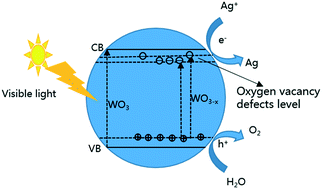Surface oxygen vacancy and defect engineering of WO3 for improved visible light photocatalytic performance†
Abstract
Lattice defects of semiconductors have a tremendous influence on the photo-absorption and separation of photogenerated electron–hole pairs; thus the photocatalytic performance of a semiconductor can be modulated by creation of defects on/in it. In this work, WO3−X photocatalysts with oxygen vacancies were prepared from highly crystalline WO3 by vacuum heat treatment. The resulting WO3−X samples with defects were characterized by Raman, XPS, DRS, ESR and photocatalytic water oxidation experiments. The results revealed that the visible light absorption of WO3−X increased with increasing vacuum heat treatment temperature. The surface oxygen vacancies of WO3−X could significantly improve the photoelectric behaviour. WO3−X showed the maximum photocurrent density, which is 3 times higher than that of the pristine WO3, and a much higher photocatalytic activity than the pristine WO3. The surface oxygen vacancies on WO3−X played a more important role in the separation of photogenerated electron–hole pairs and improvement of the photocatalytic activity than the bulk defects. These results indicated that controlling of the number and types of oxygen vacancies on WO3 is important to obtain high-performance WO3−X photocatalysts.



 Please wait while we load your content...
Please wait while we load your content...